Nikko
last update: November 17, 2021
Nikko (日光, Nikkō) is a town in the mountains in Tochigi prefecture, about 140 km north of Tokyo. The village of Nikkō developed around the Rinnō-ji temple, founded in 766 by the Buddhist monk Shōdō Shōnin, followed by the Chūzen-ji temple in 784. Over the centuries the area became an important mountain religious center, until in 1617 Nikko was chosen as a place to bury the national hero Tokugawa Ieyasu, inside the Toshogu Shrine. Thanks to the priceless historical buildings that distinguish it, Nikko is now part of the UNESCO World Heritage Sites and a very popular tourist destination. Finally, Nikko is located within the Nikko National Park, a vast protected landscape area full of mountains, lakes, waterfalls and hot springs.
Things to do and things to see in Nikko
The area around Nikko stations where tourists usually arrive (JR station and Tobu station) is nothing interesting. Anyone who arrives in Nikko usually immediately continues north for about 2 km, on foot or by bus to get to the most famous area of the city, the sacred area of
Nikko Sannai.
Nikko Sannai
Shinkyo Bridge
(to cross it 500¥, opening hours 8-16, until 17 Apr-Set)
A bridge over the Daiya River which practically marks the access to the Sannai area, north of the river. It is considered to be one of the three most beautiful bridges in Japan. The current one was built in 1636, but on the site there was another one of unclear origins long ago, which was called Yamasuge-no-Jabashi, literally "Bridge of the Serpents". In fact, legend has it that the monk Shodo Shonin and his disciples, who arrived in nico in the year 766 and who would soon have founded the Rinnoji temple on the other bank, were unable to cross the river due to the currents and began to pray, until a god appeared, Jinja Daio, who launched two snakes, one blue and one red, which arranged themselves over the river, forming a bridge and allowing them to cross it, and then disappeared. Today the bridge can be admired and photographed by crossing the river via a modern bridge built right next to it, while if you want to cross the Shinkyo Bridge you have to pay 500 yen.
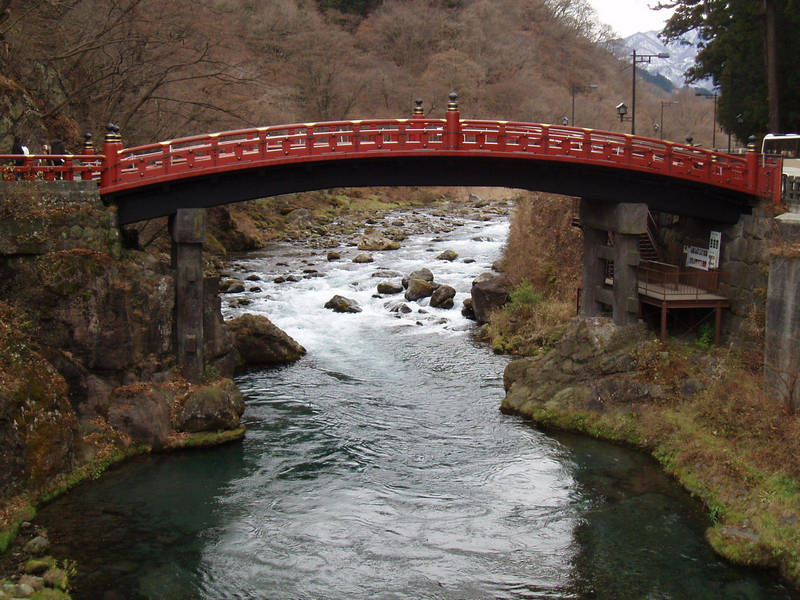
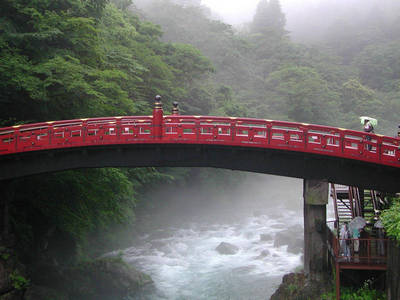
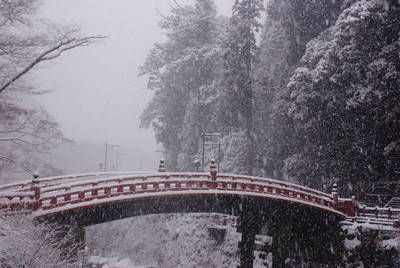 Shinkyo Bridge, in the fog and with the snow
Shinkyo Bridge, in the fog and with the snow
Toshogu Shrine
(admission 1300¥, opening hours 9-17, fino alle 16 Nov-Mar)
This shrine is the mausoleum of Tokugawa Ieyasu, founder of the Tokugawa shogunate, whose dynasty ruled Japan for 250 years starting from 1603. The grounds of the shrine are very vast and immersed in the forest, where to find numerous religious buildings with both Buddhist and Shinto styles. Indeed, it was common for many places of worship to contain elements of both religions, at least until the Meiji period, when Shinto was deliberately separated from Buddhism. Throughout the country, Buddhist elements were removed from Shinto shrines and vice versa, but at Toshogu Shrine the two religions were so intertwined that it was not possible to completely remove Buddhist elements. Among the most important buildings, there is a 5-storey pagoda (36 meters) built in 1650, destroyed by fire and rebuilt in 1818. Also very famous is the entrance door in the south, the Yōmeimon Gate, also called Higurashi-no-mon gate, which literally means "The gate that people would spend all day looking at it". In fact, there are well 508 sculptures. Among the 5173 (!!) sculptures scattered throughout the Toshogu Shrine, the three wise monkeys are very famous. Finally, outside the paid area of the shrine, there is the Nikko Toshogu Museum (1000¥), inaugurated in 2015 to commemorate the 400th anniversary of Tokugawa Ieyasu's death. The museum displays a collection of the former shogun's personal effects.
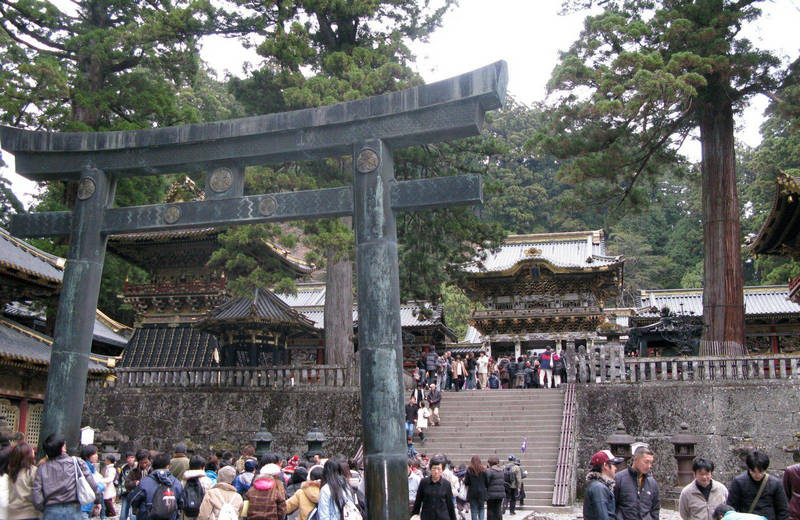 the entrance to the Toshogu Shrine, in the background the Yōmeimon Gate
the entrance to the Toshogu Shrine, in the background the Yōmeimon Gate
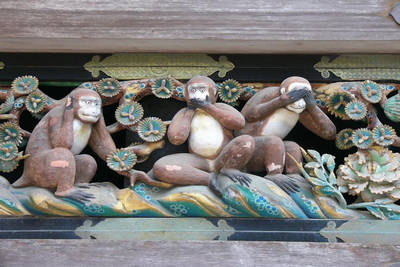
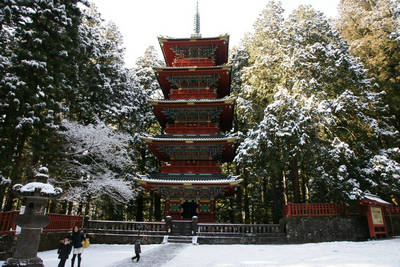 sculpture of the "three wise monkeys" (symbol of the Buddhist principle "hear no evil, say no evil, look no evil") and pagoda inside the Toshogu Shrine
sculpture of the "three wise monkeys" (symbol of the Buddhist principle "hear no evil, say no evil, look no evil") and pagoda inside the Toshogu Shrine
Rinnoji Temple
(admission 400¥, opening hours 8-17, until 16 Nov-Mar)
A large complex of Buddhist temples, the most important in Nikko, founded in 766 by the Buddhist monk Shodo Shonin. The main building is the Sanbutsu-doh Hall, inside which there are 3 famous statues of Buddha golden lacades (Amida Buddha, Senju-Kannon, Bato-Kannon).
Near the Rinnoji temple there is also a Japanese-style garden built in the Edo period and very popular in autumn, the Shoyoen Garden, and, next to it, the Treasure House, a small museum that exhibits objects related to Buddhism and the Tokugawa family. The entrance to these two places must be paid separately (300¥).
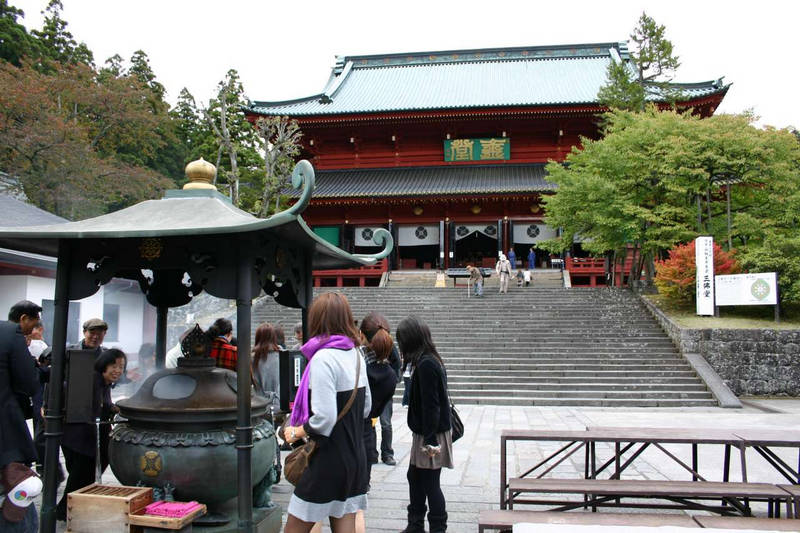 Rinnoji Temple's Sanbutsu-doh Hall
Rinnoji Temple's Sanbutsu-doh Hall
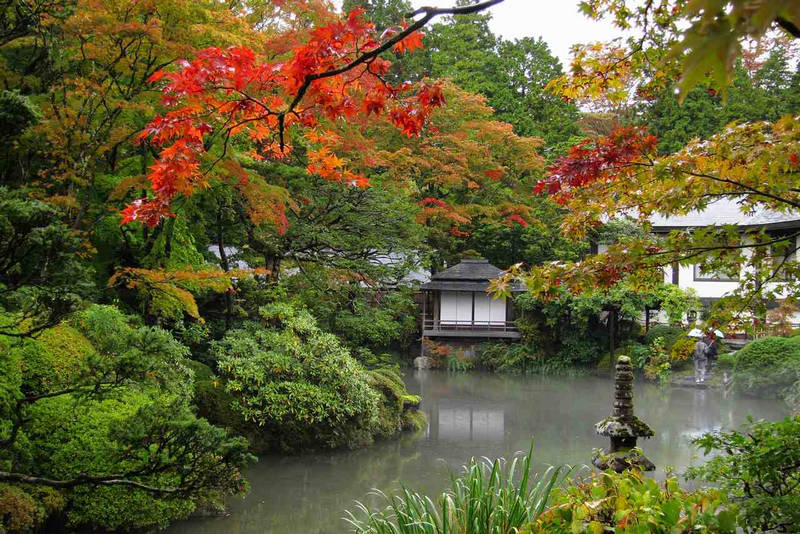 Shoyoen zen garden
Shoyoen zen garden
Futarasan Shrine (Futarasan jinja)
(admission gratuito, opening hours 8-17, fino alle 16 Nov-Mar)
A Shinto shrine founded in 782 by the same Shodo Shonin whose legend of the Shinkyo Bridge (which is formally part of this shrine) and who also founded the Rinnoji Temple. The Shrine is dedicated to the deities of Nikko's three holiest mountains: Mount Nantai, Mount Nyoho and Mount Taro. The sanctuary area can be accessed almost completely free of charge, with the exception of a small paid area (200¥) with a small garden and other minor buildings. Two other Futarasan shrines are located in the nearby area of Okunikko.
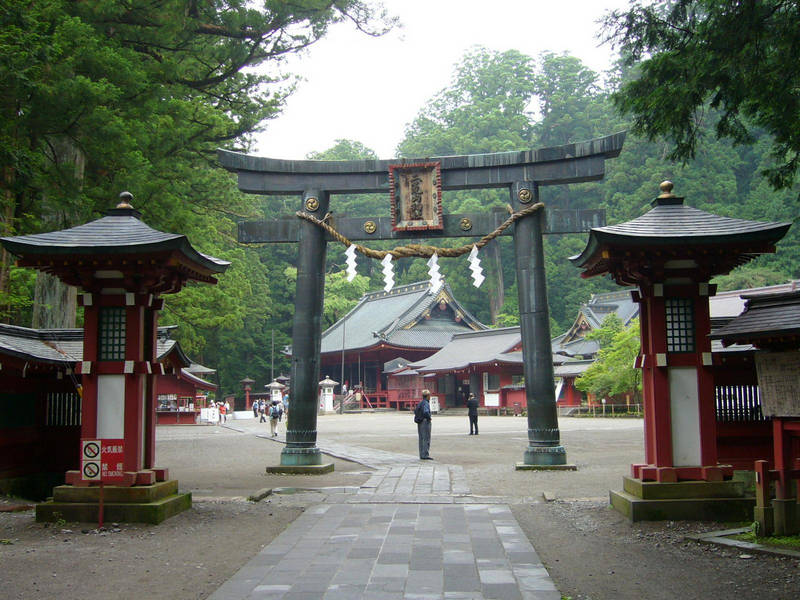 entrance to the Futarasan Shrine
entrance to the Futarasan Shrine
Taiyuinbyo
(admission 550¥, opening hours 8-17, until 16 Nov-Mar)
The mausoleum of shogun Iemitsu Tokugawa (1604-1651), third shogun of the dynasty and grandson of founder Ieyasu Tokugawa buried at the nearby Toshogu shrine. The mausoleum complex has a structure similar to that of the nearby Toshogu, but less sumptuous and more modest, precisely at the behest of Iemitsu as a symbol of respect for his grandfather. Like Toshogu, Taiyuin features a mix of Buddhist and Shinto styles, but unlike Toshogu (officially a Shinto shrine), Taiyuin has become part of the nearby Rinnoji Buddhist temple. A combined ticket (900¥) allows the visit of both.
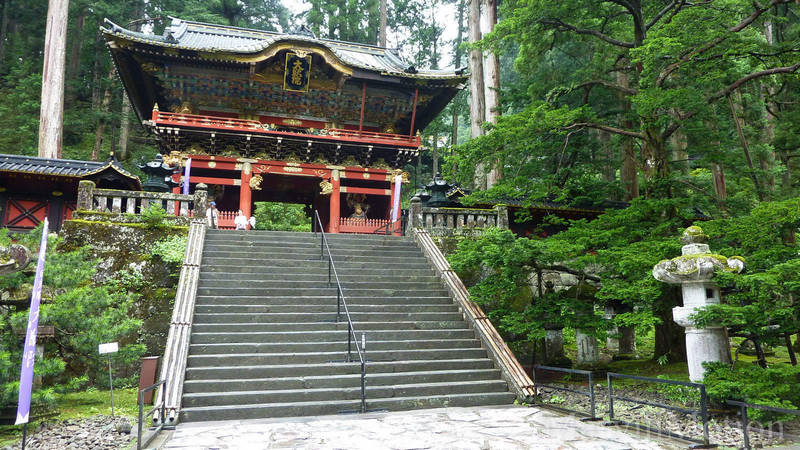 entrance to the Taiyuinbyo
entrance to the Taiyuinbyo
Other places of interest
In addition to the temples and shrines of Nikko Sannai, walking for about 20 minutes on foot from the Sankyo Bridge following the course of the river and crossing a residential area, you reach another interesting area. South of the river you will find seventy Buddhist statues lined up along the river, north of the river there are the
Tamozawa Villa and the
Nikko Botanical Garden. Also, from Nikko you can take a bus that takes you to the beautiful region of
Okunikko.
Kanmangafuchi Abyss
A very particular gorge along the Daya River, formed during a distant eruption of nearby Mount Nantai and characterized by a succession of small waterfalls. You can observe this natural spectacle by walking along a path beside the river. At one point along the path, the tranquility of nature is joined by a long series of Buddhist statues depicting jizo, a deity who protects children. Many of these statues wear small red caps and bibs, often donated by the parents of children who have lost their lives. The atmosphere here becomes mystical and spiritual. Some curious "rumors" surround this place, for example it is said that the statues periodically change arrangement and no one has ever seen them in the same position, or that it is impossible to count the exact number (officially they are seventy statues).
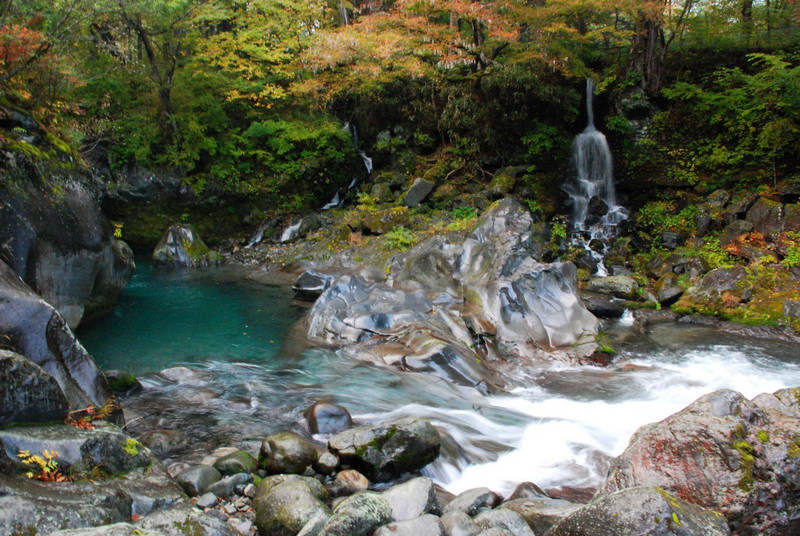 Kanmangafuchi Abyss, Daiya river (credits)
Kanmangafuchi Abyss, Daiya river (credits)
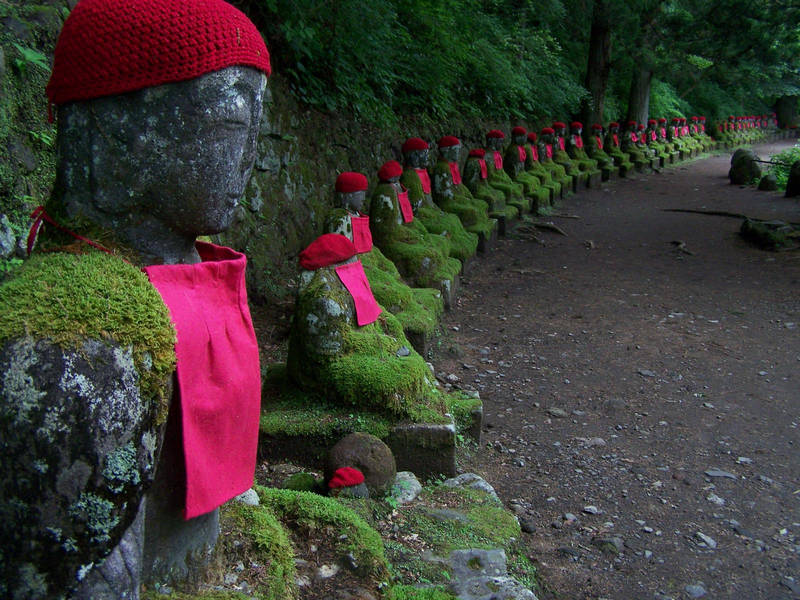 Jizo statues near the Kanmangafuchi Abyss
Jizo statues near the Kanmangafuchi Abyss
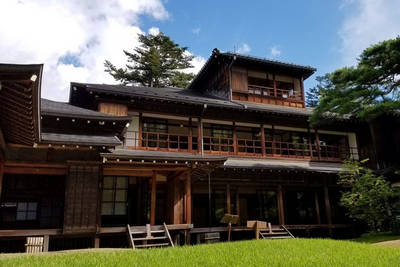
Tamozawa Villa Memorial Park
(admission 550¥, opening hours 9-17, fino alle 16:30 Nov-Mar, closed every Tuesday)
This huge 4500 square meter, 106 room villa was built in 1899 as the summer vacation residence of the imperial family. It is the only example of an ancient imperial villa left in Japan. Very interesting is the architecture of the building which brings together the styles of the Edo, Meiji and Taisho eras, and is one of the largest wooden buildings in the whole country. The interior is also very particular as it is furnished partly in Japanese style, partly in Western style. Finally, the Villa is surrounded by a garden, and the whole occupies an area of thirty thousand square meters, which, just think, are only less than a third of the area originally occupied.
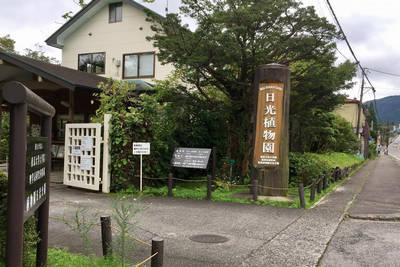
Botanical Garden
(admission 500¥, opening hours 9:00-16:30, closed on Mondays and in winter from 1st December to 14th April)
A botanical garden owned by the prestigious University of Tokyo, originally born in 1902 to study alpine varieties. It is located right next to the Tamozawa Villa and next to the river, from the inside you can also see the Kanmangafuchi Abyss area. Today the park is open to the public and in addition to a special section dedicated to alpine plants, and another dedicated to swamp plants, it has many other trees and plants from all over Japan. The main botanical garden of the University of Tokyo is located in Tokyo (Koishikawa Botanical Garden ).
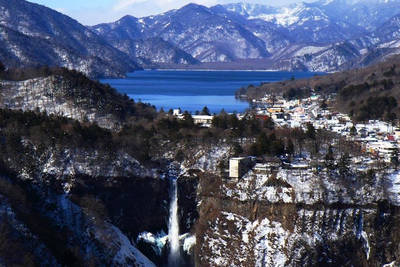
Okunikko
Buses run continuously from Nikko stations to the Okunikko region, whose famous Lake Chuzenji is less than an hour away.
Where to stay in Nikko
Nikko is often visited on a day trip from Tokyo by foreign tourists. However, if you also want to explore the nearby area of
Okunikko it is recommended that you spend at least two days and sleep at least one night in Nikko or Okunikko. In this area you can also have the opportunity to experience a
ryokan and the experience of traditional hot springs.
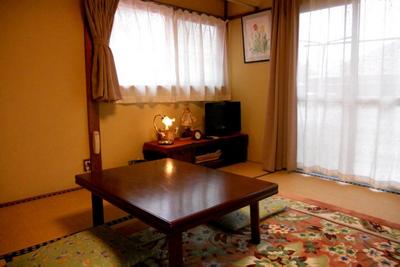 A small family run establishment (minshuku) near Nikko train stations. Very kind owners, they even come to pick you up at the station with their car if you notify them of your arrival. Single and double rooms, in Japanese style and equipped with all basic amenities, bathrooms are shared with other guests. The property has very few rooms so it is advisable to book well in advance. One of the best solutions for those who want to stay overnight in Nikko and spend little.
Price range: 3,500-6,000¥.
A small family run establishment (minshuku) near Nikko train stations. Very kind owners, they even come to pick you up at the station with their car if you notify them of your arrival. Single and double rooms, in Japanese style and equipped with all basic amenities, bathrooms are shared with other guests. The property has very few rooms so it is advisable to book well in advance. One of the best solutions for those who want to stay overnight in Nikko and spend little.
Price range: 3,500-6,000¥.
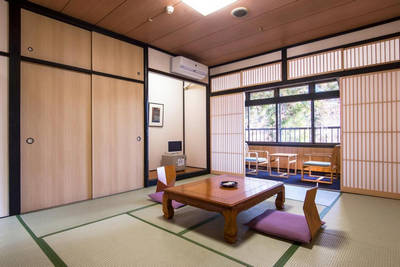 A hotel with Japanese-style rooms, with tatami mats and futons but equipped with all comforts, within the sacred area of Nikko, a stone's throw from the Shinkyo Bridge and the famous temples and shrines. From the station you can easily get there by bus or in 20 minutes on foot. Inside the structure there is also an onsen, with indoor and outdoor pools, and the possibility of enjoying an excellent breakfast, lunch and dinner strictly in Japanese style in the on-site restaurant. Mid-range prices, but still among the lowest in the area for this type of hotel.
Price range: 9,000-12,000¥.
A hotel with Japanese-style rooms, with tatami mats and futons but equipped with all comforts, within the sacred area of Nikko, a stone's throw from the Shinkyo Bridge and the famous temples and shrines. From the station you can easily get there by bus or in 20 minutes on foot. Inside the structure there is also an onsen, with indoor and outdoor pools, and the possibility of enjoying an excellent breakfast, lunch and dinner strictly in Japanese style in the on-site restaurant. Mid-range prices, but still among the lowest in the area for this type of hotel.
Price range: 9,000-12,000¥.
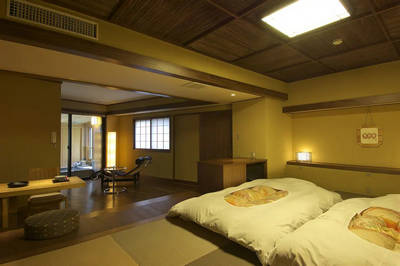 If you don't have any budget issues, and want to experience a modern ryokan experience in Nikko Sannai, this is a fantastic choice. The rooms are Japanese in style, but modern and sophisticated in design, and with a view of the river and the surrounding nature. Some rooms also have an open-air bathtub on a private balcony overlooking the river. Half-board with typical Japanese breakfast and kaiseki-style dinner is usually included. A memorable experience.
Price range: 30,000-45,000¥.
If you don't have any budget issues, and want to experience a modern ryokan experience in Nikko Sannai, this is a fantastic choice. The rooms are Japanese in style, but modern and sophisticated in design, and with a view of the river and the surrounding nature. Some rooms also have an open-air bathtub on a private balcony overlooking the river. Half-board with typical Japanese breakfast and kaiseki-style dinner is usually included. A memorable experience.
Price range: 30,000-45,000¥.
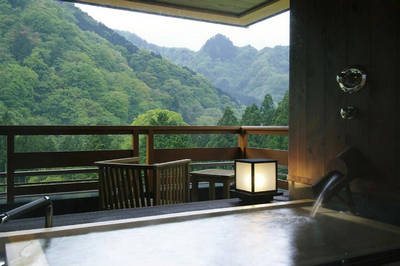 Another luxurious ryokan with a mixture of traditional and modern style near the sacred area of Nikko. Here, too, the rooms overlook the river and the surrounding nature, in a magical atmosphere. The rooms are huge, starting at 40 square meters, and all with tatami mats and futons. Also in this structure it is possible to choose rooms with an open-air bathtub on a private balcony overlooking the river. Again, breakfast and dinner are generally included and are superb. It's very difficult to choose between this and the previous ryokan.
Price range: 30,000-45,000¥.
Another luxurious ryokan with a mixture of traditional and modern style near the sacred area of Nikko. Here, too, the rooms overlook the river and the surrounding nature, in a magical atmosphere. The rooms are huge, starting at 40 square meters, and all with tatami mats and futons. Also in this structure it is possible to choose rooms with an open-air bathtub on a private balcony overlooking the river. Again, breakfast and dinner are generally included and are superb. It's very difficult to choose between this and the previous ryokan.
Price range: 30,000-45,000¥.
How to get to Nikko
Nikko is located about 120 kilometers north of Tokyo, and is one of the most popular destinations among foreign tourists looking for a worthwhile day trip from the Japanese capital. Nikko and Tokyo are connected by the private company Tobu Railway and Japan Railways (JR).
By Tobu Railway
Tobu connects Nikko with
Tobu Asakusa station in Tokyo. The cheaper alternative are local trains, which take around 2.5 hours and cost 1390¥, however, you will need to make at least a couple of train changes en route. Alternatively, the limited express trains take around 2 hours and connect the two stations directly, but cost 2700¥ one way.
For Japan Rail Pass holders
If you have the Japan Rail Pass and can therefore travel "for free" on the JR lines, then it is good to use it. To reach Nikko, take the
JR Tohoku Shinkansen from Ueno or Tokyo station to Aomori but be careful to get off at
Utsunomiya station, after approximately 45 minutes. At Utsunomiya Station, take another JR line, the
Nikko line to Nikko (terminus), which takes another 45 minutes. In total, you should be able to get to Nikko from Tokyo in 100-110 minutes including the waiting time for the connection in Utsunomiya. Taking this route without having the Japan Rail Pass is very expensive, it is not even worth considering the idea.
Direct trains from Shinjuku Station
Since a few years ago, thanks to a collaboration between JR and Tobu Railway, there are also limited-express trains that directly connect Shinjuku station with Nikko in about 2 hours. However, the service is very expensive (4080¥) and the Japan Rail Pass only partially covers the route. An alternative to take into consideration only in limited circumstances, for example if you are staying near Shinjuku station.
Map of Nikko, Tochigi
Guided tours, activities and other things to do
If you are planning a trip to Japan and you want to do something more than just visiting famous places and monuments, we suggest you to use
Rakuten Travel Experiences.
How to use Rakuten Travel Experiences
Rakuten Travel is a very useful website to
enrich your travel experience, especially if you are going solo or it's your first time in Japan.
Because of the language barrier (and more), in Japan it is very difficult to interact with the locals and to get off the tourist track.
Thanks to Rakuten Travel you can find a lot of interesting and sometimes unique
guided tours and activities all over Japan (and not only in Japan), that you would otherwise never be able to enjoy.
But there's more: on Rakuten Travel you can also
buy tickets for several famous attractions, events, transportation and other useful services for tourists. Last but not least, you can
reserve a table in hundreds of restaurants.
Some examples
Take a look at Rakuten Travel Experiences
You may also be interested in

 sculpture of the "three wise monkeys" (symbol of the Buddhist principle "hear no evil, say no evil, look no evil") and pagoda inside the Toshogu Shrine
sculpture of the "three wise monkeys" (symbol of the Buddhist principle "hear no evil, say no evil, look no evil") and pagoda inside the Toshogu Shrine
 Kanmangafuchi Abyss, Daiya river (credits)
Kanmangafuchi Abyss, Daiya river (credits)



 A small family run establishment (minshuku) near Nikko train stations. Very kind owners, they even come to pick you up at the station with their car if you notify them of your arrival. Single and double rooms, in Japanese style and equipped with all basic amenities, bathrooms are shared with other guests. The property has very few rooms so it is advisable to book well in advance. One of the best solutions for those who want to stay overnight in Nikko and spend little.
Price range: 3,500-6,000¥.
A small family run establishment (minshuku) near Nikko train stations. Very kind owners, they even come to pick you up at the station with their car if you notify them of your arrival. Single and double rooms, in Japanese style and equipped with all basic amenities, bathrooms are shared with other guests. The property has very few rooms so it is advisable to book well in advance. One of the best solutions for those who want to stay overnight in Nikko and spend little.
Price range: 3,500-6,000¥.
 A hotel with Japanese-style rooms, with tatami mats and futons but equipped with all comforts, within the sacred area of Nikko, a stone's throw from the Shinkyo Bridge and the famous temples and shrines. From the station you can easily get there by bus or in 20 minutes on foot. Inside the structure there is also an onsen, with indoor and outdoor pools, and the possibility of enjoying an excellent breakfast, lunch and dinner strictly in Japanese style in the on-site restaurant. Mid-range prices, but still among the lowest in the area for this type of hotel.
Price range: 9,000-12,000¥.
A hotel with Japanese-style rooms, with tatami mats and futons but equipped with all comforts, within the sacred area of Nikko, a stone's throw from the Shinkyo Bridge and the famous temples and shrines. From the station you can easily get there by bus or in 20 minutes on foot. Inside the structure there is also an onsen, with indoor and outdoor pools, and the possibility of enjoying an excellent breakfast, lunch and dinner strictly in Japanese style in the on-site restaurant. Mid-range prices, but still among the lowest in the area for this type of hotel.
Price range: 9,000-12,000¥.
 If you don't have any budget issues, and want to experience a modern ryokan experience in Nikko Sannai, this is a fantastic choice. The rooms are Japanese in style, but modern and sophisticated in design, and with a view of the river and the surrounding nature. Some rooms also have an open-air bathtub on a private balcony overlooking the river. Half-board with typical Japanese breakfast and kaiseki-style dinner is usually included. A memorable experience.
Price range: 30,000-45,000¥.
If you don't have any budget issues, and want to experience a modern ryokan experience in Nikko Sannai, this is a fantastic choice. The rooms are Japanese in style, but modern and sophisticated in design, and with a view of the river and the surrounding nature. Some rooms also have an open-air bathtub on a private balcony overlooking the river. Half-board with typical Japanese breakfast and kaiseki-style dinner is usually included. A memorable experience.
Price range: 30,000-45,000¥.
 Another luxurious ryokan with a mixture of traditional and modern style near the sacred area of Nikko. Here, too, the rooms overlook the river and the surrounding nature, in a magical atmosphere. The rooms are huge, starting at 40 square meters, and all with tatami mats and futons. Also in this structure it is possible to choose rooms with an open-air bathtub on a private balcony overlooking the river. Again, breakfast and dinner are generally included and are superb. It's very difficult to choose between this and the previous ryokan.
Price range: 30,000-45,000¥.
Another luxurious ryokan with a mixture of traditional and modern style near the sacred area of Nikko. Here, too, the rooms overlook the river and the surrounding nature, in a magical atmosphere. The rooms are huge, starting at 40 square meters, and all with tatami mats and futons. Also in this structure it is possible to choose rooms with an open-air bathtub on a private balcony overlooking the river. Again, breakfast and dinner are generally included and are superb. It's very difficult to choose between this and the previous ryokan.
Price range: 30,000-45,000¥.